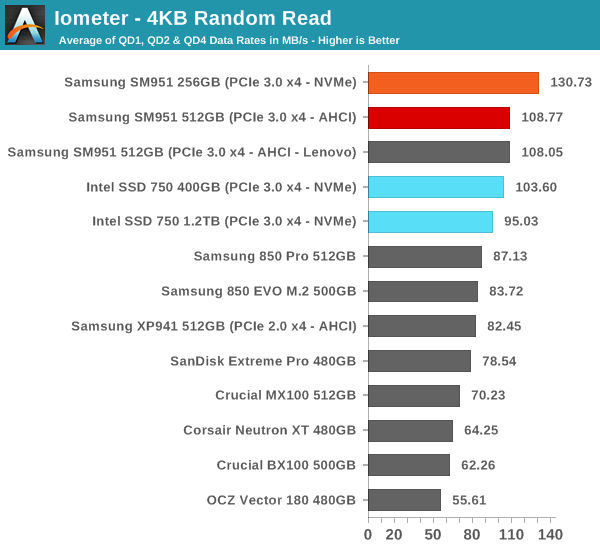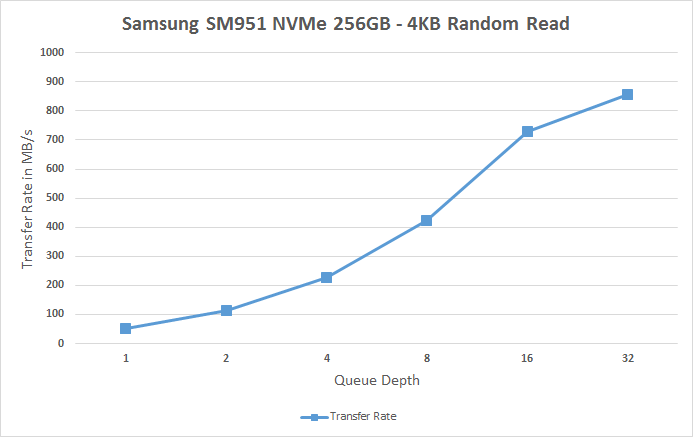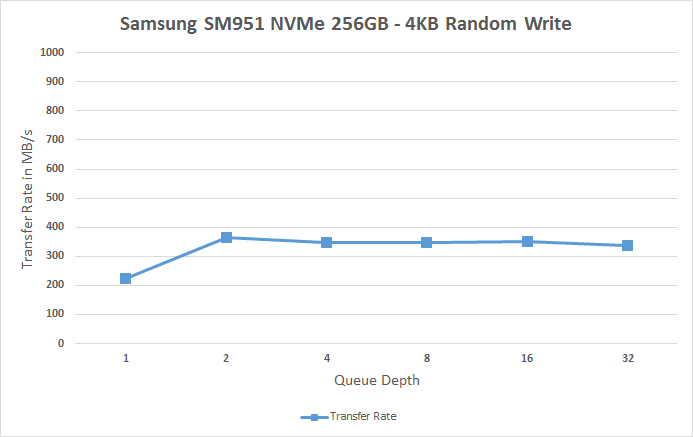Samsung SM951-NVMe (256GB) PCIe SSD Review
by Kristian Vättö on June 25, 2015 9:40 AM ESTRandom Read Performance
For full details of how we conduct our Iometer tests, please refer to this article.

This is the graph I've been dying to see ever since I first heard about NVMe. Random read performance at low queue depths was mostly bottlenecked by AHCI latency because at QD1 the controller can only read from one NAND die (it's asked to read one 4KB chunk of data at a time), meaning that a tremendous share of the latency was caused by the command overhead. As the NVMe command set is much simpler and the whole IO stack is lighter, it opens the doors for improved low queue depth performance, which is exactly what we are seeing with the SM951 NVMe.
 |
|||||||||
| Default | |||||||||
At QD1 the SM951 NVMe offers about 50MB/s, whereas the best AHCI drives I've seen hover around 30-35MB/s, resulting in about 50% gains. Performance at QD2 and QD4 is also better than what other drives offer and in general the SM951 NVMe has excellent random read performance including the high QDs as well.
Random Write Performance

NVMe doesn't present similar gains to random write performance, though. This is an area where Intel clearly has an advantage, but given that the SSD 750 carries an 18-channel controller that is hardly a surprise. Moreover, because the SSD 750 features full power loss protection Intel can cache more user data in the DRAM buffer without the risk of data loss, which can further improve random write performance as IOs can be combined more efficiently. Intel's custom driver may also help with random write performance because the native Microsoft driver has some write performance issues due to Force Unit Access (basically FUA won't consider write to be complete until it has been written to its final medium i.e. NAND, whereas Intel's driver can consider write to be complete when it reaches the DRAM buffer).
 |
|||||||||
| Default | |||||||||










74 Comments
View All Comments
Laststop311 - Friday, June 26, 2015 - link
the pci-e ssd's also improve the 4k qd1/2 as well not by huge amounts but it is faster in that as well.cenpjas - Monday, June 29, 2015 - link
Ignoring OS for the moment, I am not so sure about "for the end consumer I'm not sure it matters as much over a SATA SSD. After all, the typical average user probably values the 4k @QD1/2 above all else, so perhaps these PCI-E SSDs will remain a niche product, unless the price reaches near parity with SATA SSDs, which won't happen for at least a few years."Currently most people build there own computers are for gaming or specialist use and it is a large market. The advantages of M.2 drives is not just the 4 fold increase in read or 3 fold increase in write speeds over SATA SSD (based on a SM951 VS 850 Evo) but an improved latency over these 'legacy' SSD's. So if your going to throw down £600 for a graphics card would you think twice about a 'mear' £100 more for a 512Gb SM951 VS 500Gb 850 Evo?
For me M.2 is here and now, and SATA SSD's are secondary storage drives. As I build my self very small computers, I like the storage taking up no space in the case. (although I suspect a few small heat sinks in the short term on the drives will need to be the case in a restricted air flow environment). As far as I can tell the SM951-NVMe just makes me more certain that I want it as my primary drive.
As for Win10.0.0 I notice from the Open Beta's that out the box boot support is very good and I can not imagine there being no out the box support for all M.2 type devices, after all, these are OEM for the most part.
epobirs - Thursday, July 2, 2015 - link
You've got to be kidding. An order of magnitude performance increase will become a serious market driver once mainstream availability is there. It's one of those things that has to be experienced to be appreciated. There was a time when SSDs in general seemed like an exotic upgrade for the hot rodders who spent absurd amounts on their systems. Now, I wouldn't consider building a new system without one unless price was the sole priority.There is no reason for the price gap to last beyond this year. Once the chip sets are in production with shippable firmware you're looking at mostly the same same silicon for nearly the entire product. Since prices are very much lower than when SSDs hit the market, PC OEMs aren't faced with the same marketing problems as before. (Though what would remove the final barrier would be for Microsoft to offer functionality comparable to the Apple Fusion Drive in Windows 10.) The cost of having a conventional SATA hard drive for bulk storage alongside a 256-ish GB PCIe SSD for OS and apps is far lower than when the same companies were faced with decisions on how to offer SATA SSDs.
IMHO, the mainstream market will never experience SATA SSD but instead will go direct to PCIe SSDs because that will be the first version the PC OEMs push for mainstream consumers.
dgingeri - Thursday, June 25, 2015 - link
I'd still prefer my 512GB 850 Pro over this.vnangia - Thursday, June 25, 2015 - link
Curious why? Is it just cost-related?I actually recently bought an XP941 to use as a boot drive and have been damn impressed; I needed all the SATA ports for a ZFS array. Even in AHCI mode, it clocked in 850 read/700 write typical, with a peak of 1100/850.
Notmyusualid - Sunday, June 28, 2015 - link
Sounds butt hurt to me...Impulses - Thursday, June 25, 2015 - link
I think I'd like a 256GB SM951 + 1TB 850 EVO setup... Probably going for the latter first tho, my 2x 128GB 830 are definitely getting a little long in the tooth and ditching the games/media drive would be sweet.scan80269 - Thursday, June 25, 2015 - link
Hi Kristian, the Z97 motherboard you used to test SM951 supports only up to PCIe gen2. The SM951 (both AHCI & NVMe versions) support up to PCIe x4 gen3. The sequential read & write figures are lower with the SM951 running at PCIe gen2 compared to gen3. To run SM951 at PCIe gen3 speed you will need an upcoming Intel Skylake platform, with something like Z170 chipset. Even Intel's Broadwell CPUs (like in that NUC) support up to PCIe gen2 only.wyysoft - Thursday, June 25, 2015 - link
Why can’t Z97 support PCIe Gen3? No Z170 chipset is needed to get PCIe Gen3 results.Kristian Vättö - Thursday, June 25, 2015 - link
The SSD is connected directly to the CPU's PCIe lanes and Intel's CPUs have supported PCIe Gen 3 since Ivy Bridge. Skylake and 100-series chipsets will only affect the PCIe lanes coming from the PCH.